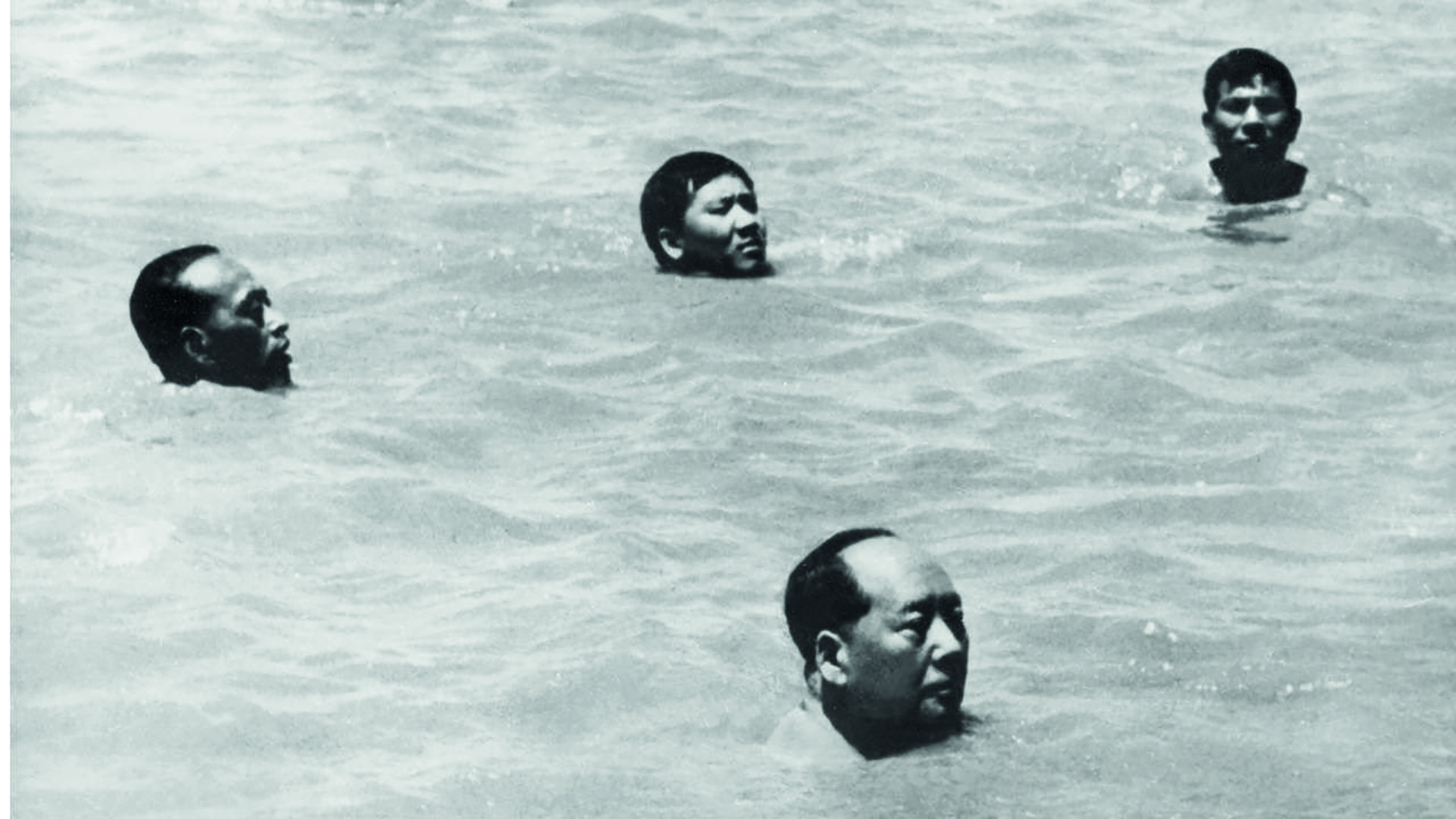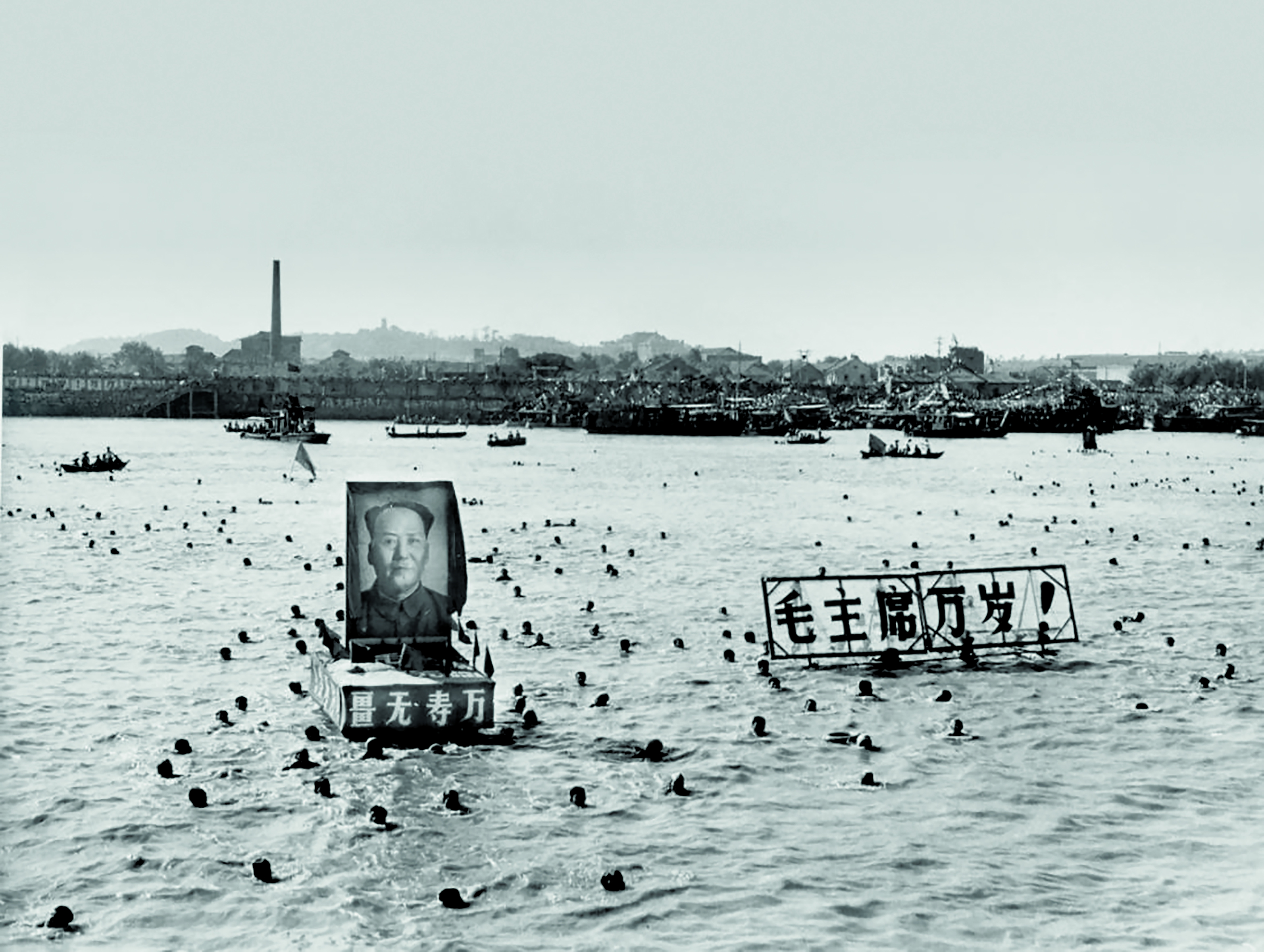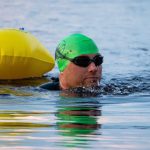Chairman of the Rivers – The Strange Swimming History of Mao Zedong
A life-long swimmer, Mao Zedong used his athletic achievements for political gain. By Elaine K Howley
Born to a wealthy farmer in Hunan province in 1899, Mao Zedong served as the first Chairman of the Communist Party of China from the party’s founding in March 1943 until his death in September 1976. An opportunist, a showman, a savvy propagandist and an often-calculating tyrant, Mao ruled through a mix of manipulation and paranoia, terror and ruthless policies. Though he is often credited with expelling imperialism from China and modernising what had been a vast and largely insular domain into a world power, these advances came at the cost of intense ethnic repression, destruction of religious and cultural artifacts and sites, and an estimated 30 to 70 million lives.
During his reign, Mao hid behind a curtain of cultivated personality; the details of his own day-to-day life were not discussed, rather the propagandistic public persona as the saviour of his people was burnished regularly through the use of universally glowing news reports, posters and other media. The upside to being a dictator, at least prior to the advent of “fake news” it seems, is that you can control your own image with little domestic reproach.
But what Mao perhaps didn’t bank on was the careful chronicling of what was really going on behind the walls of his various residences across China by Dr Li Zhisui, the Chairman’s personal physician from 1954 until Mao’s death in 1976. During those 22 years, Li traveled with the leader and kept copious notes of what he observed. Although he burned the original notes during the Cultural Revolution, fearing that frequent raids on his living quarters would land his remembrances in the wrong hands, upon emigrating to the United States in 1988, he drafted a frank and intimate memoir of his time as Mao’s physician. “The Private Life of Chairman Mao” was published in 1994.
Li recorded many instances of political intrigue and detailed the extravagant lifestyle and odd sexual proclivities of China’s top communist. Aside from the salacious details, what’s most interesting is how much of the Chairman’s life revolved around a love for the water; Li recorded many instances of Mao swimming.

He floated on his back, his big belly sticking up like a round balloon
The Three Rivers
Li reported that Mao “had begun swimming as a child, using the pond on his father’s property to learn, and was a good swimmer.” It seems Mao had carried that love of water with him throughout his life. But Mao also understood that his swimming skills might help paint himself in a glowing light, an important step in building his cult of personality. This led in 1956 to a desire to stage a show of strength involving three of China’s greatest rivers.
Thus, began an odyssey to swim the Pearl River, the Xiang River and the mighty Yangtze River, which encompasses some 35 per cent of all the freshwater in China. At 6,380 kilometres long, the Yangtze is Asia’s longest river and the third longest river in the world. It flows from the glacial meltwaters of the Tanggula Mountains across 10 provinces and empties in the East China Sea near Shanghai.
It would be a brilliant plan to make the 63-year old appear youthful and vigorous, but there was just one problem: his safety and security. These concerns were born out in the very first visit to the Pearl River when one of Mao’s bodyguards was bitten by a water snake. Snakes were one thing, but the real concern was the cleanliness of these urban waterways. Although he was a strong swimmer, “everyone responsible for his safety had tried to persuade him not to swim, but the more his security staff tried to protect him, the more he insisted on swimming,” Li wrote. “He was defying us all, telling us symbolically that it was useless to attempt to restrain him.”
For Mao, swimming made a statement that carried significant political and personal importance. “The saga of his swim in three great rivers, over the objections of his security men, symbolized his solitary struggle against the bureaucracy, his fear that the revolution might bog down, and his challenge to comrades he thought were betraying his radical aims,” writes Professor Andrew J Nathan in the foreword of Li’s book.
Undeterred, when the contingent arrived at the Pearl River for a safety assessment, the 63-year old Mao “descended a ladder over the side and plunged into the water, trailed by a squadron of twenty to thirty guards, followed by the other leaders. I plunged into the water after them, joining the protective circle around Mao,” Li wrote. “Mao’s decision had come so unexpectedly that he was the only one wearing a bathing suit. The rest of us were in our underwear.”
Once in the water, the gentle current swept them all along. “The water, just as I feared, was filthy. I saw occasional globs of human waste float by. The pollution did not bother Mao. He floated on his back, his big belly sticking up like a round balloon, legs relaxed, as though he were resting on a sofa. The water carried him downstream, and only rarely did he use his arms or legs to propel himself forward.” They floated down the river for two hours, covering six or seven miles.
Mao considered the swim a resounding success that renewed his vigour for swimming all three rivers. Mao and his coterie forged onward, with the colossal Yangtze perched as the ultimate goal but also the ultimate risk. “That Mao should swim the Yangtze was truly unthinkable,” Li wrote. “It is the mightiest of China’s rivers, the swiftest and most dangerous, with strong currents and whirlpools. No one had ever swum in the Yangtze River before. But Mao wanted to swim the Yangtze anyway.” And what Mao wanted, Mao got.

Mao Zedong swimming in the Yangtze in 1966
Return to Wuhan
With his successful completion of these three swims, Mao solidified his position as virile sportsman and statesman. Or at least that’s the portrait painted by party propaganda. Over the next 10 years, the China Media Project reports, Mao swam the Yangtze at Wuhan 17 times.
That last Yangtze swim in 1966 was the source of great worldwide fanfare and a publicity stunt of sorts to help launch Mao’s Great Proletarian Cultural Revolution – a sociopolitical movement intended to preserve true communist ideals by purging capitalist and traditional elements of society and creating a cult of personality around the Chairman. The swim spectacle would mark Mao’s return to health and reaffirm his authority, a necessary step for his nascent Cultural Revolution to take hold, it was reasoned. After all, he’d been ill for a few months and had passed many of his public duties on to underlings while he convalesced.
Thus, the Chairman entered the water on 16 July 1966 to participate in the 11th cross-Yangtze contest, a mass swim across the river involving some 5,000 people in the industrial city of Wuhan. The event had been staged annually since Mao’s first triumph in the Yangtze a decade before to celebrate his feat, but this one became a major event on the world stage with his previously unannounced intention to participate.

Olympic time
Preforming his customary float, Mao reportedly swam nine miles down the river in 65 minutes, the San Francisco Chronicle reported. If moving at a 9-mile-per-hour weren’t enough, it was reported that, Mao “discovered that a girl knew only one swimming stroke,” so “he taught her the backstroke,” in mid-stream.
While the adulation came thick and fast in China, courtesy of state-run media, it seems not everyone believed the claims. A 17 August 1966 article in the Honolulu Star-Bulletin reported that “a Hong Kong sports writer, who says that the Chairman is a backstroke man, has estimated that even allowing for a favoring current, Mao must have swum fast enough to beat the world backstroke swimming champion by seven minutes.” That same report laments the burden of being Chinese under the leadership of such a puffed-up persona. “In most other countries, when a politician of 72 years jumps into a river and swims nine miles in Olympic time, his admirers may caution him to take things a little easier and his detractors will suggest that he has gone soft in the head.” But in China, “when Mao swims, everyone swims.”
Propaganda machine
This wasn’t necessarily only the state propaganda machine at work. It seems Mao had a strong desire to lead his people into better health and athletic accomplishment, and an early political paper he wrote in 1917, “A Study of Physical Culture” highlighted the benefits of regular exercise and swimming as a means of combating the pernicious and pervasive concept of the “Sick Man of Asia,” that had resulted from the nation’s battering during the Opium Wars of the mid 19th century. It seemed that if Mao could inspire his people to physically strengthen themselves, they might in turn restore the country as a whole to its previous glory. Through his very visible efforts in open water, Mao became a sort of swimming coach for the nation, inspiring other people to take up the sport. “Swimming is fighting against nature. Toughen yourself up in the rivers and sea,” Mao reportedly said.
While the specifics of his athletic performance at Wuhan in 1966 are debatable and drew derisive giggles in the West, the fact that he made this vigorous public appearance when he did was nothing short of revolutionary, writes Stuart Heaver in a 2016 edition of the South China Morning Post. “He entered the waters at Wuhan the old man of the revolution, his nascent Cultural Revolution still fragile in its conception. He emerged reborn in the eyes of the nation, the inheritor of modern China and once more the Great Helmsman, ready to lead the country to its true revolutionary destiny. Today’s most accomplished spin doctor could not have planned it better.” Bobbing merrily like a swollen teabag on the surface of the brown, polluted water, Mao wouldn’t have traded his heroic swim in the Yangtze for all the tea in China.
Restored to glory, Mao would enjoy his role as authoritarian leader for the next decade, though his ability to swim soon began to ebb along with his health. Still, he remained in contact with his passion if indirectly; his indoor swimming pool was converted into his living quarters. Mao is still remembered in China as having been a strong proponent of physical culture and the wonders of swimming, and every year, a mass event is staged on the Yangtze – though today it’s reported as an 1800-metre affair that draws international competitors. The appeal of swimming the Yangtze remains strong; in 2004, the Big River Man himself, Martin Strel, swam more than 4,000 kilometres (nearly 2,500 miles) down the Yangtze River in 40 days. Perhaps the Chairman would have been impressed.






